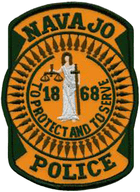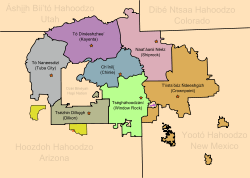Navajo Nation Police
The Navajo Nation Police (formerly known as the Navajo Tribal Police) is the law enforcement agency on the Navajo Nation in the Southwestern United States. It is under the Navajo Division of Public Safety. It is headed by a Chief of Police, six Police Captains and eight Police Lieutenants. It includes: Internal Affairs, Patrol, K-9 Unit, Police diving, Tactical Operations Team, Traffic Unit, Fiscal management, Recruitment, and Training Divisions. The Navajo Nation Police are responsible for seven districts: Chinle, Crownpoint, Dilkon, Kayenta, Shiprock, Tuba City, and Window Rock. There are also several substations in each district ranging from one-man substations or up to five officers each. Currently, there are 210 sworn police officers(134 patrol), 28 criminal investigators and 279 civilians, acting as support staff for the department . There are approximately 1.9% police officers per 1,000 people and one officer is responsible for patrolling 70 square miles (180 km2) of reservation land. The Navajo Nation Police are funded by federal contracts and grants and general Navajo Nation funds. This police department is one of only two large Native American police Departments with 100 or more sworn officers in the United States (the other is the Oglala Lakota Nation's police department).[1]
| Navajo Nation Police | |
|---|---|
 | |
| Agency overview | |
| Formed | 1872 |
| Employees | 549 |
| Jurisdictional structure | |
| Operations jurisdiction | USA |
 | |
| Map of Navajo Nation Police's jurisdiction. | |
| Size | 27,000 square miles (70,000 km2) |
| General nature | |
| Operational structure | |
| Headquarters | Window Rock, Arizona |
| Police Officers | 134 |
| Civilians | 279 |
History
The Navajo Treaty of 1868, which released Navajos from captivity at Fort Sumner, established law enforcement as the responsibility of the federal government. The first Navajo police force was created in 1872 and dissolved three years later. Although there were police on the reservation, they were funded and supported by the United States government. The Navajo Nation Police Department was not re-established until 1959 at the request of the Navajo Tribal Council. The Navajo Nation police is responsible for law enforcement and for the care and custody of prisoners.
Equipment and vehicles

All officers are issued a service Glock 22 40 caliber sidearm, expandable baton, handcuffs, bullet-resistant vest, pepper spray and portable radio linked to a central dispatch. Rural substation officers are issued take-home vehicles, a shotgun, metal spike strips and speed radar guns. There are 200 vehicles in the Police department's fleet ranging from sport utility vehicles (SUV) such as: Chevrolet Tahoe, Chevrolet Blazer, Chevrolet Suburban and Jeep Liberty to Sedans: Chevrolet Impala. There are Kawasaki Kz1000s for motor units, 4-Wheel all-terrain vehicles (ATV) for special events/crowd control, and street bicycle units. All patrol vehicles are currently outfitted with laptop computer technology working with local Wi-Fi internet connection to assist officers to write and file reports electronically. The department recently obtained a mobile command post vehicle which is assigned to the Shiprock district located in Shiprock, New Mexico.
In 2018 chief of police Phillip Francisco restarted the Navajo Nation police academy, using the former Chinle jail as a training headquarters. Twelve new recruits graduated in June 2018, the first in-house graduates in ten years.[2]
Fallen officers
Since the establishment of the Navajo Nation police department, at least fourteen officers have died in the line of duty.[3]
Fictional portrayals
Officers of the Navajo Nation police are the subjects of a series of mystery novels by Tony Hillerman. The novels deal primarily with fictional officers named Joe Leaphorn, Jim Chee, and Bernadette Manuelito. After Tony Hillerman's death in 2008, daughter Anne Hillerman has continued the mystery series.
The Hillerman novels and characters were used in a 2002 PBS television series Skinwalkers: The Navajo Mysteries.
Navajo police are also the subjects of the Ella Clah police procedural romance novels by the husband and wife authorial team of Aimee and David Thurlo.
References
- Wakeling, Stewart; Jorgensen, Miriam; Michaelson, Susan; and Begay, Manley. Policing on American Indian Reservations. Washington D.C.: United States Department of Justice; 2001. p. vi.
- Cindy Yurth (December 27, 2018). "2018: Year of schism". Navajo Times. p. A1.
- The Officer Down Memorial Page